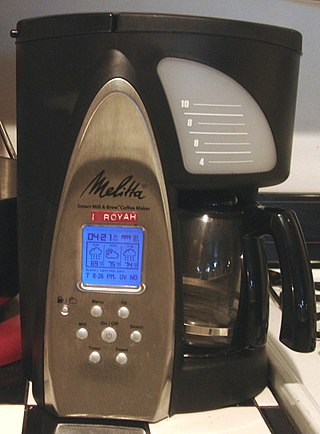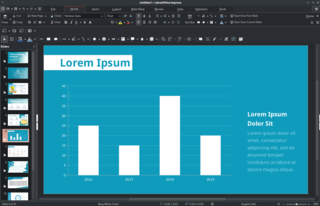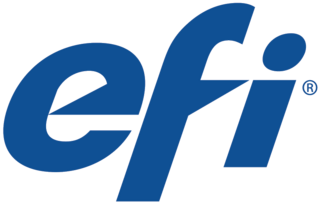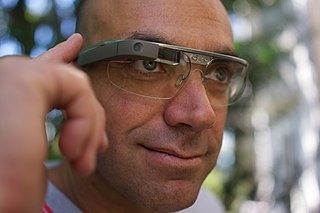
ATI Technologies Inc., commonly called ATI, was a Canadian semiconductor technology corporation based in Markham, Ontario, that specialized in the development of graphics processing units and chipsets. Founded in 1985, the company listed publicly in 1993 and was acquired by AMD in 2006. As a major fabrication-less or fabless semiconductor company, ATI conducted research and development in-house and outsourced the manufacturing and assembly of its products. With the decline and eventual bankruptcy of 3dfx in 2000, ATI and its chief rival Nvidia emerged as the two dominant players in the graphics processors industry, eventually forcing other manufacturers into niche roles.

The Smart Personal Objects Technology (SPOT) is a discontinued initiative by Microsoft to create intelligent and personal home appliances, consumer electronics, and other objects through new hardware capabilities and software features.

In computing, a presentation program is a software package used to display information in the form of a slide show. It has three major functions:

ViewSonic Corporation is an American privately held multinational electronics company with headquarters in Brea, California, United States.
A volumetric display device is a display device that forms a visual representation of an object in three physical dimensions, as opposed to the planar image of traditional screens that simulate depth through a number of different visual effects. One definition offered by pioneers in the field is that volumetric displays create 3D imagery via the emission, scattering, or relaying of illumination from well-defined regions in (x,y,z) space.

A handheld projector is an image projector in a handheld device. It was developed as a computer display device for compact portable devices such as mobile phones, personal digital assistants, and digital cameras, which have sufficient storage capacity to handle presentation materials but are too small to accommodate a display screen that an audience can see easily. Handheld projectors involve miniaturized hardware, and software that can project digital images onto a nearby viewing surface.

An interactive whiteboard (IWB), also known as interactive board, interactive display, interactive digital board or smart board, is a large interactive display board in the form factor of a whiteboard. It can either be a standalone touchscreen computer used independently to perform tasks and operations, or a connectable apparatus used as a touchpad to control computers from a projector. They are touch screen enabled small computers.They are used in a variety of settings, including classrooms at all levels of education, in corporate board rooms and work groups, in training rooms for professional sports coaching, in broadcasting studios, and others.
Mimio is a brand name of a line of technology products aimed at the education market. The primary products were originally focused around computer whiteboard interactive teaching devices. MimioCapture devices also allow users to capture all of the ink strokes that are written on the whiteboard. When used in conjunction with a video projector it turns the ordinary whiteboard surface into a fully interactive whiteboard. The product line has been dramatically expanded in the last two years as described in the "Hardware Products" and "Software Products" sections below.
Laser color television, or laser color video display, is a type of television that utilizes two or more individually modulated optical (laser) rays of different colors to produce a combined spot that is scanned and projected across the image plane by a polygon-mirror system or less effectively by optoelectronic means to produce a color-television display. The systems work either by scanning the entire picture a dot at a time and modulating the laser directly at high frequency, much like the electron beams in a cathode ray tube, or by optically spreading and then modulating the laser and scanning a line at a time, the line itself being modulated in much the same way as with digital light processing (DLP).
BrightSide Technologies Inc. was a firm spun-out from the Structured Surface Physics Laboratory of the University of British Columbia, developing and commercializing electronic display technologies, specifically high brightness display technology called HDR. The privately held company also developed technology for capturing, processing, and storage of HDR images. BrightSide's headquarters were in Vancouver, British Columbia, Canada. It was acquired by Dolby Laboratories, Inc. in April 2007 for US$28 million.

Microsoft PixelSense was an interactive surface computing platform that allowed one or more people to use and touch real-world objects, and share digital content at the same time. The PixelSense platform consists of software and hardware products that combine vision based multitouch PC hardware, 360-degree multiuser application design, and Windows software to create a natural user interface (NUI).
SMART Technologies is a Canadian company headquartered in Calgary, Alberta, Canada and wholly owned by Foxconn. Founded in 1987, SMART is best known as the developer of interactive whiteboards branded as the "SMART Board" popularly used in education and business.

Computer graphics deals with generating images and art with the aid of computers. Computer graphics is a core technology in digital photography, film, video games, digital art, cell phone and computer displays, and many specialized applications. A great deal of specialized hardware and software has been developed, with the displays of most devices being driven by computer graphics hardware. It is a vast and recently developed area of computer science. The phrase was coined in 1960 by computer graphics researchers Verne Hudson and William Fetter of Boeing. It is often abbreviated as CG, or typically in the context of film as computer generated imagery (CGI). The non-artistic aspects of computer graphics are the subject of computer science research.
Luidia, Inc. produces portable interactive whiteboard technology for classrooms and conference rooms. Its eBeam hardware and software products work with computers and digital projectors to use existing whiteboard or writing surface as interactive whiteboards.

Electronics for Imaging, Inc. (EFI) is an international company based in Silicon Valley that specializes in digital printing technology. Formerly located in Foster City, California, the company is now based in Fremont. On July 1, 2015, EFI entered the textile printing marketing with the acquisition of Italian digital textile company Reggiani Macchine. On June 16, 2016, EFI acquired Optitex, a 3D digital workflow provider.

PrimeSense was an Israeli 3D sensing company based in Tel Aviv. PrimeSense had offices in Israel, North America, Japan, Singapore, Korea, China and Taiwan. PrimeSense was bought by Apple Inc. for $360 million on November 24, 2013.
Annabeth Robinson, whose online Second Life alias is AngryBeth Shortbread, is a multi-media artist and lecturer based in Leeds, UK where she focusses on the teaching of audio, visual and online technologies. Using Second Life and other Multi User Virtual Environments (MUVEs), Robinson explores their potential as a medium for art and design practice whilst examining its educational potential. Robinson has been undertaking such projects since 2005.

Efraim R. "Efi" Arazi was an Israeli technology pioneer and businessman.

An optical head-mounted display (OHMD) is a wearable device that has the capability of reflecting projected images as well as allowing the user to see through it. In some cases, this may qualify as augmented reality (AR) technology. OHMD technology has existed since 1997 in various forms, but despite a number of attempts from industry, has yet to have had major commercial success.
The Samsung Flip is an interactive whiteboard developed by Samsung Electronics released in January 2018. The device was announced during Samsung's keynote speech at CES 2018, with planned distribution in the United States and Europe. It consists of a screen available in sizes of 55", 65", 75", or 85" and a dual-sided stylus pen. Accessories are available to either mount the display on the wall or attach it on a height-adjustable moving stand. The Samsung Flip is aimed at enterprise clients, similar to the Jamboard and Surface Hub.










